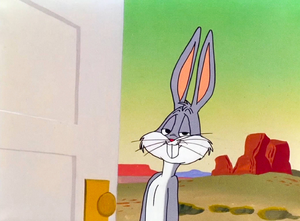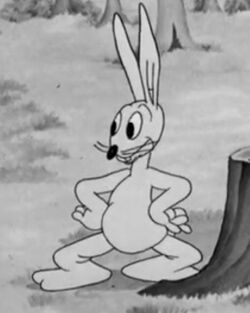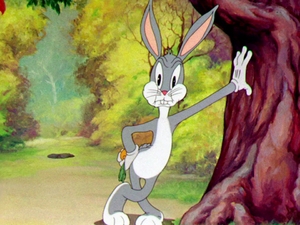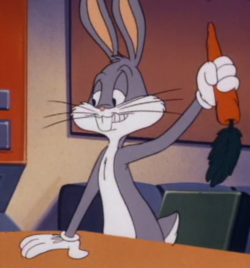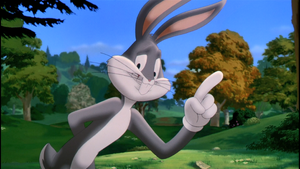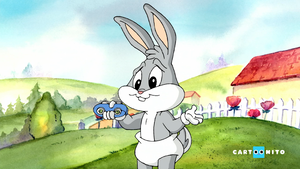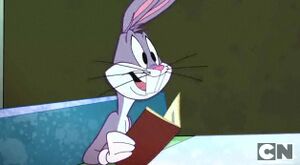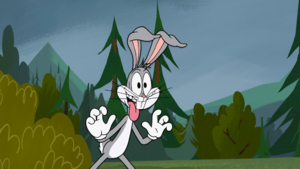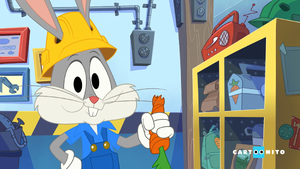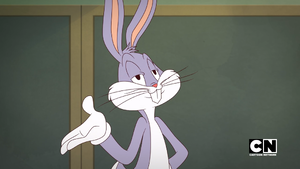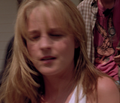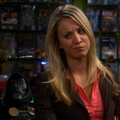Bugs Bunny (character)
- This article is about the character. For other uses, see Bugs Bunny.
Bugs Bunny is an anthropomorphic rabbit and is one of the main characters of the Looney Tunes and Merrie Melodies theatrical shorts. He is a trickster known for his pronounced Brooklyn accent, mischievous personality, and his catchphrase, "What's up, Doc?" His voice was originated by Mel Blanc.
Although not the first Looney Tunes character, or the first popular Warner Bros. Cartoons star, Bugs is recognized for being one of the most beloved and recognizable cartoon characters. He is also the mascot of the Warner Bros. company.
Bugs' protégés in Tiny Toon Adventures are Buster Bunny and Babs Bunny.
Character description
| “ | Ain't I a stinker? ― Bugs Bunny, various Looney Tunes and Merrie Melodies cartoons |
” |
Bugs Bunny is tall, slim rabbit with grey fur and white gloves. He is frequently described as a shrewd, levelheaded, and charismatic trickster, adept at outsmarting anyone who dares to cross him. His personality traits—which are marked by both his cleverness and irreverence—are what give him a distinct edge over his enemies, rivals, and opponents. Bugs almost always wins in his conflicts, a pattern that repeats in his appearances. He speaks in a pronounced Brooklyn accent, which underscores his streetwise demeanor, in addition to adding his own flare of speech. He is recognized for eating a carrot in a nonchalant fashion, followed up by him saying his well-known catchphrase, "What's up, Doc?" Bugs is also known for regularly breaking the fourth wall, fully aware that he is a fictional animated character, and often using it as a comedic or strategic advantage.
Director Bob Clampett described Bugs' personality in the following text, which he wrote as if Bugs were describing himself:
"Some people call me cocky and brash, but actually I am just self-assured. I'm nonchalant, imperturbable, contemplative. I play it cool, but I can get hot under the collar. And above all I'm a very 'aware' character. I'm well aware that I am appearing in an animated cartoon....And sometimes I chomp on my carrot for the same reason that a stand-up comic chomps on his cigar. It saves me from rushing from the last joke to the next one too fast. And I sometimes don't act, I react. And I always treat the contest with my pursuers as 'fun and games.' When momentarily I appear to be cornered or in dire danger and I scream, don't be consoined – it's actually a big put-on. Let's face it, Doc. I've read the script and I already know how it turns out."
- Bob Clampett, written in first person[1]
Bugs is often the target of many antagonists, including (but not limited to) Elmer Fudd, Yosemite Sam, Marvin the Martian, Beaky Buzzard, the Tasmanian Devil, Cecil Turtle, Witch Hazel, Rocky and Mugsy, Pete Puma, the Crusher, and Daffy Duck. Bugs is never malicious, and will often try to placate the antagonist and avoid direct conflict, but once pushed too far, he retaliates in ways that humiliate his opponent.
Earlier portrayals from the early 1940s—such as in the Bob Clampett's cartoons like Wabbit Twouble (1941) and The Wacky Wabbit (1942)—feature a more chaotic version of his personality, where Bugs chooses to befuddle his foils to a greater comedic effect, and is less concerned about the moral justifications of his actions. He was initially portrayed as immature and wild, but the by 1950s, his personality matured, and became less frenetic in tone.
Under the direction of Chuck Jones, his retaliations are almost always justified; Bugs responds only when he feels provoked or wronged, such as in Long-Haired Hare (1949), where he faced an arrogant opera singer who hates folks songs, or in Rabbit Hood (also 1949), when he is unfairly caught for trespassing the King's domains. Furthermore, Jones' portrayal of Bugs emphasizes more on his intelligence during conflict, rather than brute force.
In Friz Freleng's cartoons, Bugs leans more towards his wittiness, which is underscore by his playful demeanor, similar to his appearances in Clampett's shorts. However, he is more composed in these cartoons and also has an altruistic edge, which he uses to great effect to more brutish opponents like Yosemite Sam. Bugs' personality in Robert McKimson's shorts is more hands-on, and is usually emphasized by his assertive, brash nature; more capable of foiling his adversaries through physical means than actual wit, especially early on.
Additionally, Bugs is a master of disguise, often using them to confuse his enemies, with some having a certain preference to cross-dressing as female. This was especially evident in What's Opera, Doc? (1958), in which he disguises himself as the Valkyrie Brunhilde to fool Elmer (as the demigod Siegfried) into falling in love with him.
Appearances
TV series
- The Bugs Bunny Show
- Merrie Melodies Starring Bugs Bunny & Friends
- Tiny Toon Adventures
- Taz-Mania
- 1.3 "War and Pieces" (non-speaking video game character)
- 1.5 "A Devil of a Job" (no lines)
- Batman: The Animated Series
- 1.42 "Joker's Wild" (no lines)
- Bugs 'N' Daffy
- Baby Looney Tunes
- The Looney Tunes Show
- New Looney Tunes
- Teen Titans Go!
- 5.52 "Teen Titans Roar!" (drawing)
- 6.35 "Huggbees" (cardboard cutout)
- 7.6 "A Little Help Please" (silhouette book drawing)
- 8.24/25 "Warner Bros. 100th Anniversary"
- Animaniacs
- 1.2C "Suffragette City" (no lines)
- Bugs Bunny Builders
- Tiny Toons Looniversity
Movies
- Bugs Bunny: Superstar
- The Bugs Bunny/Road Runner Movie
- The Looney Looney Looney Bugs Bunny Movie
- Bugs Bunny's 3rd Movie: 1001 Rabbit Tales
- Daffy Duck's Fantastic Island
- Daffy Duck's Quackbusters
- Who Framed Roger Rabbit?
- Gremlins 2
- Space Jam
- Looney Tunes: Back in Action
- ¡Mucha Lucha!: The Return of El Maléfico (no lines)
- Teen Titans Go! See Space Jam (archival scenes from Space Jam)
- Space Jam: A New Legacy
- Bye Bye Bunny (announced)
Shorts
- Main article: List of Bugs Bunny shorts
Note: The following section contains a select filmography of his classic shorts. The rest can be found under the main article above.
- Looney Tunes & Merrie Melodies
- Porky's Hare Hunt
- A Wild Hare
- The Heckling Hare
- Wabbit Twouble
- Bugs Bunny Gets the Boid
- Super-Rabbit
- Little Red Riding Rabbit
- What's Cookin', Doc?
- Hare Ribbin'
- Hare Trigger
- Old Grey Hare
- Racketeer Rabbit
- The Big Snooze
- Rhapsody Rabbit
- Long-Haired Hare
- Haredevil Hare
- Hillbilly Hare
- Rabbit of Seville
- What's Up Doc?
- Rabbit Fire
- French Rarebit
- Operation: Rabbit
- Rabbit Seasoning
- Duck Amuck
- Bully for Bugs
- Southern Fried Rabbit
- Duck! Rabbit, Duck!
- Devil May Hare
- Bewitched Bunny
- Sahara Hare
- Hare Brush
- Rabbit Rampage
- What's Opera, Doc?
- Show Biz Bugs
- Person to Bunny
- False Hare
- Invasion of the Bunny Snatchers
- Carrotblanca
- (Blooper) Bunny!
Specials
- Bugs and Daffy's Carnival of the Animals
- Bugs Bunny in King Arthur's Court
- Bugs Bunny's Looney Christmas Tales
- Bugs Bunny's Bustin' Out All Over
- Bugs Bunny's Easter Funnies
- Bugs Bunny in Space
- Bugs Bunny's Howl-oween Special
- How Bugs Bunny Won the West
- Bugs Bunny's Cupid Capers
- Bugs Bunny's Baby Boomers
- Bugs Bunny's Thanksgiving Diet
- The Bugs Bunny Mystery Special
- Bugs Bunny: All American Hero
- Bugs Bunny's Mad World of Television
- Bugs vs. Daffy: Battle of the Music Video Stars
- Bugs Bunny's Wild World of Sports
- Bugs Bunny's Overtures to Disaster
- Bugs Bunny's Creature Features
- Bugs Bunny's Lunar Tunes
Comics
- Looney Tunes (Dell Comics)
- Bugs Bunny (Dell Comics)
- Bugs Bunny (Gold Key Comics)
- Bugs Bunny (DC Comics)
- Looney Tunes (DC Comics)
- Superman & Bugs Bunny
- Legion of Super-Heroes/Bugs Bunny Special
- Issue #1A: "The Imposter Superboy!"
- Issue #1B: "Tales of the Legion of the Super-Heroes"
- Batman/Elmer Fudd Special
- Issue #1A: "Pway For Me"
- Issue #1B: "Rabbit Season"
- MultiVersus: Collision Detected
Video games
- The Bugs Bunny Crazy Castle
- The Bugs Bunny Birthday Blowout
- The Bugs Bunny Crazy Castle 2
- Looney Tunes
- Bugs Bunny Rabbit Rampage
- Acme Animation Factory
- Looney Tunes B-Ball
- Bugs Bunny in Double Trouble
- Space Jam
- Bugs Bunny & Lola Bunny: Operation Carrot Patch
- Bugs Bunny: Lost in Time
- Bugs Bunny: Crazy Castle 3
- Bugs Bunny in Crazy Castle 4
- Looney Tunes Racing
- Looney Tunes: Space Race
- Bugs Bunny & Taz: Time Busters
- Looney Tunes Collector: Martian Alert!
- Looney Tunes Collector: Martian Revenge!
- Loons: The Fight for Fame
- Looney Tunes: Back in Action
- Looney Tunes: Acme Arsenal
- Looney Tunes: Cartoon Conductor
- Scooby Doo! & Looney Tunes Cartoon Universe: Adventure
- Looney Tunes Dash
- Looney Tunes: World of Mayhem
- MultiVersus
- Looney Tunes: Wacky World of Sports
Theme parks
Podcasts
Biography
Original Shorts
Humble Beginnings
| This article or section is a stub. You can help the Looney Tunes Wiki by expanding it. |
Rabbit Season
| This article or section is a stub. You can help the Looney Tunes Wiki by expanding it. |
Globetrotting Wabbit
| This article or section is a stub. You can help the Looney Tunes Wiki by expanding it. |
We're All a Little Looney
| This article or section is a stub. You can help the Looney Tunes Wiki by expanding it. |
Come on and Slam! And Welcome to the Jam!
| This article or section is a stub. You can help the Looney Tunes Wiki by expanding it. |
Bugs Gets Modern
| This article or section is a stub. You can help the Looney Tunes Wiki by expanding it. |
Going Down the Rabbit Hole
| This article or section is a stub. You can help the Looney Tunes Wiki by expanding it. |
Back to Basics
| This article or section is a stub. You can help the Looney Tunes Wiki by expanding it. |
It's Hard Hat Time
| This article or section is a stub. You can help the Looney Tunes Wiki by expanding it. |
Educating at Looniversity
| This article or section is a stub. You can help the Looney Tunes Wiki by expanding it. |
Bugs Sells Out
Bugs has had cameos in other Warner Bros. Animation-produced cartoons, such as in the Batman: The Animated Series episode "Joker's Wild," appearing on the Arkham inmates' TV, being watched by the Joker, until his fellow inmates force him to change the channel.
Bugs's face pops up between other guests at Rikochet's party in the TV movie ¡Mucha Lucha!: The Return of El Maléfico.
-
What is Bugs doing in Arkham Asylum?
Titans Go!
Bugs has made several cameos in the Teen Titans Go! TV series. The first was in "Teen Titans Roar!," as a drawing of his head included in a letter from Warner Bros. to the Teen Titans in response to their enraged letter about how they hate the ThunderCats Roar! reboot.
The second time was as a life-size cardboard in "Huggbees," when the Titans investigate a crime alert at Warner Bros.' Burbank studio.
The third time is in "A Little Help Please," as a silhouette that appears on a book when Robin describes the historian-type animator.
The fourth time was in "Warner Bros. 100th Anniversary," when he appeared Bugs was a guest at a party in Burbank with other cartoon characters owned by Warner Bros.
In the TV film Teen Titans Go! See Space Jam, The Titans and the visiting Nerdlucks also watch Space Jam together, with Bugs appearing in scenes from that movie.
He is also referenced in "Squash & Stretch," when the Titans exhaust themselves in defeat for trying to retrieve their bowl of nuts from a squirrel, as the rodent gloats by saying, "Gee, ain't I a stinker?," a phrase commonly said by Bugs.
Development
Prototype
According to Chase Craig, who wrote and drew the first Bugs Bunny comic Sunday pages and the first Bugs comic book, "Bugs was not the creation of any one man; however, he rather represented the creative talents of perhaps five or six directors and many cartoon writers including Charlie Thorson."[2] A preliminary iteration of Bugs debuted in the 1938 Looney Tunes short, Porky's Hare Hunt, directed by Ben "Bugs" Hardaway and an uncredited Cal Dalton. The cartoon had a similar premise to 1937's Porky's Duck Hunt by Tex Avery, where Porky is cast as a hunter trying to track down a silly prey who constantly drives his pursuer insane. In Hare Hunt, the duck is replaced by an unnamed white rabbit with a "rural buffoon" personality. Mel Blanc provided the voice of the rabbit and gave him a heckling, guttural laugh, which he would later use for Walter Lantz's Woody Woodpecker. The rabbit was popular enough that the staff of Termite Terrance decided to use him again.[3]
The rabbit appeared a second time in Prest-O Change-O (1939), directed by Chuck Jones, as a pet rabbit of the unseen magician Sham-Fu. Compared to his previous appearance in Porky's Hare Hunt, this version of the Rabbit appears to be more controlled, while also having a cool and graceful personality. He retained the guttural laugh but was otherwise silent.
The rabbit's third appearance came in Hare-Um Scare-Um, directed again by Dalton and Hardaway. This cartoon was the first to depict him with grey fur instead of white. Like his first appearance in Porky's Hare Hunt, he retained his screwball personality. Charlie Thorson, lead animator on the film, gave the character a name. He had written "Bug's Bunny" on the model sheet that he drew for Hardaway.[3][4] In promotional material for the cartoon, including a surviving 1939 presskit, the name on the model sheet was altered to become the rabbit's own name: "Bugs" Bunny (quotation marks only used, on and off, until 1944).[5] In his autobiography, Blanc claimed that another proposed name for the character was "Happy Rabbit."[6] In the actual cartoons and publicity, however, the name "Happy" only seems to have been used in reference to Bugs Hardaway. In Hare-um Scare-um, a newspaper headline reads, "Happy Hardaway."
Tedd Pierce, the head of the story department, had been approached by Thorson, who asked him to design a better rabbit. The decision was influenced by Thorson's experience in designing hares, as he had designed Max Hare in Toby Tortoise Returns, the sequel to Disney's 1935 Silly Symphony short, The Tortoise and the Hare. For Hardaway, Thorson created the model sheet previously mentioned, with six different rabbit poses. Thorson's model sheet is "a comic rendition of the stereotypical fuzzy bunny". He had a pear-shaped body with a protruding rear end. His face was flat and had large expressive eyes. He had an exaggerated long neck, gloved hands with three fingers, oversized feet, and a "smart aleck" grin. The result was influenced by Disney's tendency to draw animals in the style of cute infants.[7] The initial creation surrounding the character stirred controversy by some people at Walt Disney Studios, who pointed out the similarities between Warner's rabbit and Max Hare.[8]
In Jones' Elmer's Candid Camera (1940), the rabbit meets Elmer Fudd for the first time. The short's version of the rabbit skews closer to the appearance of modern-day Bugs, taller and with a similar face—but retaining the more primitive voice. The short retains the rabbit's cool-headed personality from Prest-O Change-O, but acted more like a scourging bully with how he instigated on Elmer.
Official debut
While Porky's Hare Hunt was the first Warner Bros. cartoon to star the prototype Bugs Bunny, A Wild Hare, directed by Tex Avery and released on July 27, 1940, is widely considered to be the first official Bugs Bunny cartoon. It is the first film where Elmer and Bugs, both redesigned by Bob Givens, are shown in their fully developed forms as hunter and trickster, respectively; the first in which Mel Blanc uses what became Bugs' standard voice; and the first in which Bugs uses his catchphrase, "What's up, Doc?"[9]
For the film, Avery asked Givens to remodel the rabbit, which resulted the character to closely resemble Max Hare. He had a more elongated body, stood more erect, and looked more poised. As for his vocalization, Blanc gave Bugs the voice of a city slicker, which he later described as a mixture of Brooklyn and Bronx dialects.[10] The personality of Bugs was also solidified in this cartoon, where he acted more as a confident and casual trickster instead of a zany lunatic. According to animation historian Michael Barrier, the rabbit was as audacious as he had been in Hare-um Scare-um and as cool and collected as in Prest-O Change-O.[11]
Bugs's oral fixation in chewing carrots while asking, "What's up, Doc?", also began in A Wild Hare. Carrots are technically not safe for rabbits to eat, but his act was inspired by Clark Gable's character chewing a carrot in the 1934 film It Happened One Night.[12] The other directers, Friz Freleng, Robert McKimson and Chuck Jones, also cited that the scene of the film was an influence in Bugs' carrot eating habits.[13]
"'What's up Doc?' is a very simple thing. It's only funny because it's in a situation. It was an all Bugs Bunny line. It wasn't funny. If you put it in human terms; you come home late one night from work, you walk up to the gate in the yard, you walk through the gate and up into the front room, the door is partly open and there's some guy shooting under your living room. So what do you do? You run if you have any sense, the least you can do is call the cops. But what if you come up and tap him on the shoulder and look over and say 'What's up Doc?' You're interested in what he's doing. That's ridiculous. That's not what you say at a time like that. So that's why it's funny, I think. In other words it's asking a perfectly legitimate question in a perfectly illogical situation."
– Chuck Jones on the catchphrase.[14]
According to Avery, the phrase was partially inspired by an idea given by fellow animator Bob Clampett, who suggested the line "What's up, Duke?" (from the screwball comedy film My Man Godfrey). Avery additionally based the catchphrase on his recollection of expressions used in his home state of Texas, which he didn't think that much at the time.[15][8]
A Wild Hare was a huge success in theaters and received an Academy Award nomination for Best Cartoon Short Subject.[16] In an interview with biographer Joe Adamson, Avery recalled the cartoon's wide reception by stating, "We decided he [Bugs] was going to be a smart-aleck rabbit, but casual about it. That opening line of "Eh, What's up, Doc?" in the very first picture floored them [the audience] [...] They expected the rabbit to scream, or anything but make a casual remark. For here's a guy pointing a gun in his face! It got such a laugh that we said, 'Boy, we'll do that every chance we get.'"[8]
The second cartoon featuring the new Bugs, Elmer's Pet Rabbit (1941), is the first to use Bugs' name on-screen: it appears in a title card, "featuring Bugs Bunny," at the start of the film. However, unlike A Wild Hare, Bugs in the short had a noticeably different characterization; Bugs' appearance looked slightly different with yellow gloves and a lack of buck teeth, has a deeper voice, and his personality is more thuggish in comparison to his nonchalant persona from A Wild Hare. After Pet Rabbit, however, subsequent Bugs appearances returned to normal: the Wild Hare visual design and personality returned, and Blanc re-used the voice characterization from that short.
Gallery
- Main article: Bugs Bunny (character)/Gallery
Toys and merchandise
- Main article: Bugs Bunny (character)/Toys
Behind the scenes
- Despite not originating the idea, Bugs popularized the notion that rabbits enjoy eating carrots.
- Mel Blanc described that Bugs' accent is a combination of Brooklyn and Bronx dialects.[10]
- When Blanc provided the voice of Bugs in recording sessions, he would regularly spit out carrots on a wastebucket (when the script calls for it) and then continue with his lines. Blanc stated that he did not like raw carrots, and had previously tried replacing it with other vegetables like celery, but to no satisfying results.[17]
- Despite enjoying carrots, Bugs has eaten other food on occasion:
- In Elmer's Pet Rabbit, Bugs scarfs down a bucket of vegetables by instinct, despite his protests against Elmer's offering for the food.
- In Bugs Bunny and the Three Bears, Bugs asks for a ketchup bottle while consuming carrot soup, though he isn't seen using it after Junyer Bear hands the bottle to Bugs.
- In Baseball Bugs, Bugs is seen eating a bag of peanuts while being watched by the Gas-House Gorillas.
- In a 1996 interview, when Chuck Jones was asked about the idea of Bugs dressing up in drag, Jones stated that when the Warner animators made it, nobody was aware of the term "transvestite", but nonetheless did explain that they liked the concept and found it funny.[18]
- Due to Bugs Bunny's frequent use of cross-dressing, he has been seen as a positive icon among both the drag and LGBTQ+ communities.[19]
- It is suggested that the American usage of the word "nimrod," in the context of referring someone as an idiot or foolish, could be traced back to Bugs using the word to describe Elmer as "a poor little Nimrod."[20] However, the Oxford Dictionary records early negative examples of the term "nimrod", which dates back as early as 1933,[21] and Daffy also made use of its pejorative use in the 1948 short What Makes Daffy Duck.
In popular culture
| WARNING: The following section contains content that may be seen as mature or offensive to some readers. Reader discretion is advised. |
- In the Gilligan's Island episode "You've Been Disconnected," Mr. Howell tells Gilligan that he eats more carrots than Bugs Bunny.
- In the 1972 film What's Up, Doc?, Bugs Bunny is throughout the film; Judy eats a carrot while staying at the Hotel Bristol, and apart from the title reference, the catchphrase, "What's up, Doc?", is said twice by Judy; both when she first meets Howard at a drugstore, and again at an airplane during the final scene. Bugs also appears in the introductory title scene of the short What's Up Doc?, which plays as an in-flight movie while Howard confesses his love to Judy. After they both kiss each other, a portion of Bugs and Elmer's musical number in the short plays, before it cuts to a sequence of Porky Pig saying "That's all, folks!"
- In the Wait Till Your Father Gets Home episode "The Hippie," Irma complains to Harry that their plan to get rid of Claude failed when he ate through the vegetables--the entire dinner--like Bugs Bunny.
- In "Brief Re-Encounter," an episode of the British sitcom Mind Your Language, Mr. Brown catches Rajeesh reading Bugs Bunny in Comic Capers, although Ranjeet refers to the character as "Bugs the Bunny."
- In the 1980 film The Shining, Danny wears a Bugs Bunny sweater while watching a Road Runner cartoon on the television.
- In The Kids of Degrassi Street episode "Noel Buys a Suit," Chuck and Ida get into a debate on what a rabbit should eat, with Chuck saying grains because he read it in a book vs. Ida saying carrots because she saw it on TV, but Chuck mocks her by asking her if it was in a cartoon, suggesting Bugs Bunny.
- In the 1983 film Blue Thunder, when Braddock gives Lymangood a talking down, he mentions that Lymangood thought having a good time when he was a kid was watching Bugs Bunny and gnawing on a fudgsicle.
- In the 1984 Gremlins movie, there are different stuffed dolls of Bugs in the department store. Later, Bugs makes a cameo in the opening to the 1990 sequel Gremlins 2: The New Batch.
- In the 1985 Explorers movie, when Wak the alien greets Ben, he says, "What's up Doc?" in Bugs's voice (archived from a Mel Blanc performance).
- In The Golden Girls episode "Larceny and Old Lace," Blanche asks Rose what Mozart composition is a serenade in G for two violins, viola, cello, and double base, in four movements, which the latter replies that was Ein klien Nachtmusic. When Blanche asks her where she got it from, she says that it played in The Bugs Bunny/Road Runner Show, during a chase scene with Elmer Fudd and Bugs.
- In the 1987 film InnerSpace, Tuck's ex-girlfriend finds out that he is working on a project involving rabbits, with him responding "Yeah, wabbits." She then finds a talking Mattel toy of Bugs, which she plays when Tuck attempts to get closer to her, which says, "Take it easy." Tuck thinks that is good advice.
- Bugs famously appeared alongside Mickey Mouse in the 1988 Disney film Who Framed Roger Rabbit? where he is seen skydiving with Mickey and Eddie. He later appears along with a bunch of other toons near the end of the film.
- In the 1988 film Short Circuit 2, a damaged Johnny Five assures Fred that he's okay, he just has some "Bugs Bunny" to work out.
- In "Losing," an episode of the British sitcom Watching, Brenda calls her on again-off again boyfriend Malcolm at his place, when his new love interest answers the phone. Brenda later tells this to her sister and while she didn't get to ask, "What's up, doc?" she knew it was Susan.
- In the 1989 film UHF, starring "Weird Al" Yankovic, there is a poster of Bugs and Daffy in his character's apartment.
- In the Martin episode "The Parents Are Coming, The Parents Are Coming," Martin playfully asks, "What's up, Doc," when Dr. Waters catches him half naked.
- In the Seinfeld episode "The Opera," Jerry sings the theme song of The Bugs Bunny Show while waiting for George and Kramer to visit the opera. Elain mockingly tells him, "All your knowledge of high culture comes from Bugs Bunny cartoons."
- In the Boy Meets World episode "This Little Piggy," Eric gets bored at the opera until he recognizes "Ride of the Valkyries" and sings along with it because "It's Bugs Bunny." Mr. Feeny tries to be more educational by saying it's Wagner, but Eric feels he has the upper hand having watched cartoons.
- In the 1996 film Twister, Allan, a young storm chaser on Jo's team, wears a Bugs t-shirt, along with a Taz baseball cap.
- In the Beast Wars: Transformers episode "Tangled Web," Tarantulas at one point says, "Of course, you realize this means war!", which is one of Bugs' catchphrases.
- In the Everybody Loves Raymond episode "Frank Paints the House," Raymond tries to get out of helping his father paint the former's house on a Saturday morning by joining his kids to watch what he finds to be Bugs Bunny asking them if it's either "Duck season/rabbit season."
- In "Episode Two" (series 5) of the BBC Radio 4 impressionist sketch program Dead Ringers, Elton John is replaced by Phil Collins in singing for Disney's animated movies, so the former goes to other cartoons who need the "Elton John magic," such as Elmer Fudd failing to shoot Bugs Bunny in the back, set to the tune of "Candle in the Wind."
- In the My Wife and Kids episode "No Rules," Michael tries to intimate Claire into admitting she was wrong in joining Junior's independent defiance of him by putting a pay phone in the house. Junior is onto Michael, who responds in Bugs's voice, "Eh, what's up, doc?"
- In The Fairly Odd Parents TV movie Channel Chasers, Timmy, Cosmo, Wanda, and Future Timmy travel into an episode of a Bugs Bunny-like cartoon. Future Timmy, Cosmo and Wanda resemble Bugs, while the present day Timmy takes on Elmer Fudd's role as a hunter. Cosmo greets the Daffy Duck spoof with "Eh, what's up, dork?"
- In the 2004 film Fat Albert, Danielle says that she guest starred on Bugs Bunny (presumably The Bugs Bunny Show) and The Jetsons.
- In the 2005 film Wallace & Gromit: The Curse of the Were-Rabbit, Wallace references Bugs' catchphrase by saying "What's up, dog?" to Gromit, while also eating a carrot.
- In the Veronica Mars episode "The Rapes of Graff," when investigating the soon to be demolished Shark Stadium, Veronica plays dumb to a construction guy and talks about the "plunger" that Bugs Bunny uses to make explosions.
- In the video game Team Fortress 2, one of the voice lines used for the Sniper when the player dominates a Medic is, "What's up, Doc?! Heh, heh, heh!"
- In the OK K.O.! Let's Be Heroes episode "Crossover Nexus," Bugs catchphrase "Screwy ain't it," is on top of the Cartoon Network building.
- In the Doom Patrol episode "Doom Patrol Patrol," Robotman described Cyborg's hand blowing up as looking like Elmer Fudd's shotgun after Bugs Bunny had stuck a cock in it.
- In The Tom and Jerry Show episode "You Are What You Eat," Spike the dog takes a bite out of a carrot, which makes him look and act a little like Bugs when he greets Tom with Bugs' signature pose while saying, "Eh, what's up?"
- In the 2019 film Doctor Sleep, Bugs and Wile E. Coyote's appearances in Rabbit's Feat are shown when young Danny and his mother Wendy watch the short on the TV, before Danny tells her that he would be leaving to the bathroom.
- In the Blu-ray Disc audio commentary for the 2020 movie Sonic the Hedgehog the director compares Sonic to acting like a bullfighter in the bar to Bugs Bunny.
- In the Batwoman episode "Fair Skin, Blue Eyes," Galaxy Comics sells Looney Tunes comics in a stand at the front, with Bugs in some shape or form on the covers of Looney Tunes #232, #233, #235, and #239.
- In The Really Loud House episode "The Blemish Dilmesh," Lynn Sr. said, "What's up?" when he saw the new neighborhood doctor walk outside the Loud house.
- In the 2023 film The Flash, the alternate 2013 version of Barry Allen has a Looney Tunes background screen on his computer, which includes Bugs, Sylvester, Daffy Duck, Road Runner, Wile E., and Tweety.
- In the German dub for The Amazing Digital Circus episode "Pilot," the Gloink Queen calls Jax a "discount Bugs Bunny."
- In the Velma episode "Private Velmjamin," Fred wants to return a nativity miniature model with the Looney Tunes to Father O'Rourke, after Fred briefly became Catholic. Elmer Fudd is baby Jesus, Sylvester is Joseph, Granny is Mary, and Daffy, Porky, and Bugs are the three wise men.
-
The Shining.
-
InnerSpace.
-
Twister.
-
The Tom and Jerry Show.
-
Doctor Sleep.
-
Batwoman.
-
Batwoman.
-
Batwoman.
-
Batwoman.
-
The Flash.
-
Velma.
30 Rock
- "The Break-Up:" Toofer takes cultural offense to Frank dressing Tracey up like a woman for a sketch, because it stereotypes black men, but Frank innocently says that everybody loves a man dressed up as a lady and that they are the best Bugs Bunnies.
- "Cleveland:" Lemon's ringtone is revealed to be "Rise of the Valkyries," which Phoebe thinks is because she is a fan of Wagner, but it's because this is what Elmer Fudd sang, which promotes Jenna and Lemon to both sing the words, "Kill da wabbit," to the tune.
Batman: The Animated Series
- "On Leather Wings:" Bruce Wayne responds to Dr. March's phone call by answering, "What's up, Doc?"
- "Joker's Wild:" During the Joker's escape at Arkham Asylum, he utters "What a maroon," a line attributed to Bugs. Later in the episode, Bugs is briefly seen on the television when the Arkham inmates force him to change the channel.
The Big Bang Theory
- "The Excelsior Acquisition:" When Stuart, owner of the Comic Center of Pasadena, exchanges Stan Lee's home address with Penny to be his date to his cousin's wedding, Looney Tunes #179 is just about visible behind her, with the Bugs inside the mini Looney Tunes logo.
- "The Desperation Emanation:" Looney Tunes #189 is behind Stuart when he talks to the gang, with Bugs as the character icon and Bugs inside the mini Looney Tunes logo.
-
So, hard to make out, why did we bother?
-
And not much better.
Bobby's World
- "Adventures in Bobbysitting:" Derek whispers to Bobby, "If she calls Mom and Dad, this means war!", one of Bugs' catchphrases.
- "Me and Roger:" Bobby has a daydream where he is a raccoon who outsmarts his dog Roger, who in the daydream, is an Elmer-like hunter who hunts "Webblys." Bobby's catchphrase in the daydream is "What's up, dork?", a play on "What's up, Doc?"
Family Guy
- Main article: Family Guy
- "The Story on Page One:" After a bomb blows up in Meg's face, she suddenly has a beak which is turned upside down just like Daffy's in Rabbit Fire. She then uses one of Bugs' catchphrases, saying, "Of course you know this means war!"
- Stewie Griffin: The Untold Story: During the "Stewie B. Goodie" segment, Elmer and Bugs' rivalry comes to an end as Elmer fatally shoots Bugs. Bugs is voiced by Seth McFarlane.
- "E. Peterbus Unum:" Peter's grandfather, who used to work at Warner Bros., said that he wanted to call Bugs Bunny "Ephraim The R*tarded Rabbit". Everyone except Peter's grandfather turns down the name.
- "Movin' In:" While watching opera, Stewie tells Brian, "Bugs Bunny is about to make this tenor hold a note far longer than anyone should. Ain't he a stinker?" This is likely a reference to "Long-Haired Hare".
Full House
- Main article: Full House
- "The Return of Grandma:" It is a Saturday morning and Stephanie wants to watch Bugs Bunny, but Joey who would prefer to watch Yogi Bear, says Bugs Bunny is kid's stuff and that every episode is the same. He then does impressions of the usual routines of Elmer and Yosemite shooting at him. Joey thinks Bugs has a death wish and wonders why he even pokes his head out of his rabbit hole. Despite this, Stephanie thinks it's less boring than watching Yogi always steal picnic baskets.
- "Middle Age Crazy:" A 1986 Looney Tunes poster is added to Joey's bedroom in the second season onwards, featuring Bugs, Daffy, Porky, Sylvester, Road Runner, and Tweety
- "Fogged In:" The 1986 Looney Tunes poster is in Joey's bedroom.
- "Working Mothers:" The 1986 Looney Tunes poster is in Joey's bedroom.
- "Pal Joey:" The 1986 Looney Tunes poster is in Joey's bedroom.
- "El Problema Grande de D.J.:" The 1986 Looney Tunes poster is in Joey's bedroom.
- "Blast from the Past:" The 1986 Looney Tunes poster is in Joey's bedroom.
- "Nerd for a Day:" The 1986 Looney Tunes poster is in Joey's bedroom.
- "Star Search:" Joey comes home one evening, but before he enters, he surprises everyone by announcing in Yosemite's voice, "Oh, I hate that rabbit."
- "Joey & Stacy and... Oh, Yeah, Jesse:" The 1986 Looney Tunes poster is in Joey's bedroom. Also in the episode, Michelle dresses like a nurse, enters her sisters' room, and asks D.J., "What's up, Doc?"
- "13 Candles:" Michelle dances in her room with a Bugs Bunny doll bigger than her, to which her uncle Jesse comments, "Now this is a party. You got singing, dancing, cwazy wabbits..."
- "Those Better Not Be the Days:" The 1986 Looney Tunes poster is in Joey's bedroom.
- "The I.Q. Man:" The 1986 Looney Tunes poster is in Joey's bedroom.
- "Terror in Tanner Town:" The 1986 Looney Tunes poster is in Joey's bedroom.
- "Happy New Year:" The 1986 Looney Tunes poster is in Joey's bedroom.
- "Joey Goes Hollywood:" When Joey fantasizes about being a big sitcom star, Michelle says that he's funnier than Bugs Bunny, which Joey repeats when he comes out of said fantasy.
- "The Legend of Ranger Joe:" When Joey auditions to replace Ranger Roy, Joey says he does every cartoon voice known to man, and then proceeds to say "Eh, what's up, Doc?" in Bugs's voice, followed by Yosemite.
- "Happy Birthday, Babies Part 1:" A clip of Michelle dancing with her Bugs doll.
- "Nicky and/or Alexander:" When Jesse and Becky bring home the twins for the first time, Joey compares them to looking like little Elmer Fudds, and greets them in Elmer's voice, "Hewwo, you little wascally wugwats."
The King of Queens
- "Parent Trapped:" Doug is making him and Carrie late by watching the end of a cartoon involving Bugs and Cecil, even though Doug has seen it a hundred times before, and comments, "Hey, the tortoise beat Bugs Bunny. Who'd a thunk it?" But Doug responded it was about the journey, not who wins.
- "Do Rico:" When Doug tells Deacon about doing a voice for Carrie while making love, he asks curiously if he means Bugs Bunny.
Moesha
- "Sleep, Perchance to Dream:" Moesha deflects Niecy grilling her about her romantic dream involving Hakeem by bringing up her nightmare about Bugs Bunny.
- "Netcam:" At the end of the episode, Hakeem wears a sweater with Bugs on it.
The Simpsons
- Main article: The Simpsons
- "Bart the Murderer:" When Bart picks a horse called "Don't Have a Cow Man" to win a horse race, one of the horses is named "Ooh, Ain't I a Stinker?", referencing one of Bugs Bunny's catchphrases.
- "Brother's Little Helper:" Chief Wiggum says to Bart "That's the end of your Looney Tune, Drugs Bunny!"
- "The President Wore Pearls:" Homer shows Lisa a collection of Bugs Bunny postage stamps.
- "The Last of the Red Hat Mamas:" The rabbit at the Easter celebration is called Hugs Bunny, a reference to Bugs Bunny.
- "Homer the Father:" The Itchy & Scratchy cartoon in the episode is titled "Ain't I a Stinger?", punning one of Bugs Bunny's catchphrases.
- "Penny-Wiseguys:" Bart mentions Bugs Bunny during the school concert, which is playing Hungarian Rhapsody No. 2 by Franz Liszt. Bugs also played the song in the 1946 short, "Rhapsody Rabbit".
- "Treehouse of Horror XXVI:" After killing Bart in the "Wanted: Dead, Then Alive" segment, one of the lyrics Sideshow Bob sings is "I did what could not be done to Bugs Bunny by Elmer Fudd."
- "Treehouse of Horror XXIX:" The song that Bart sings in the "Multiplisa-ty" segment is "You'll Be Trapped", a parody of "This Is It", the theme song for The Bugs Bunny Show.
- "Girls in the Band:" Mr. Largo has the band hold a note for a long time, causing an overweight trumpet player's formal wear to unravel. Bugs does the same thing to the opera singer Giovanni Jones, in the 1949 short Long-Haired Hare.
Rick and Morty
- "Something Ricked This Way Comes:" Rick indirectly connects his feud with the Devil to the short Long-Haired Hare, stating, "To me this was all just a bit like when Bugs Bunny fucks with the opera singer for twenty minutes."
- "The Vat of Acid Episode:" When explaining to Morty on what negging is, Rick claims that Bugs Bunny invented it.
Robot Chicken
- Main article: Robot Chicken
- "Rodiggiti"" During "8 Carrot," Bugs battles Elmer Fudd in a rap battle, parodying the Eminem film 8 Mile. Bugs is voiced by Bill Farmer.
- "Snarfer Image:" In the skit "Wooper," Bugs is one of the people sent back in time to be killed by Elmer Fudd.
- "Immortal:" In the skit "Porky's", Bugs and Daffy mistake a strip club called Porky's for a place that Porky Pig owns, only to be proven wrong. Although they were appalled by what they saw in the strip club, they immediately go back in.
- "Not Enough Women": In "Wabbit Cwossdwessing," Bugs takes his cross dressing skills to the next level by getting gender reassignment surgery.
Two and a Half Men
- "Big Flappy Bastards:" A Bugs doll is sold at a toy store Charlie takes Jake to buy him an X-Box in.
- "One False Move, Zimbabwe:" Alan makes a bad joke about calling Walden's mother the "Gorilla of my dreams" after she says she works as a primatologist. He defends himself by saying it was hysterical when Bugs Bunny did it.
Unbreakable Kimmy Schmidt
- "Kimmy Meets a Drunk Lady!:" The second time Kimmy greets Dr. Bayden in her office, she says, "What's up, Doc?" She says she would've had a carrot in her mouth, but she dropped it on the subway.
- "Kimmy Meets an Old Friend!:" Kimmy wants Titus to wear her backpack, but he doesn't want to because it makes him feel like a turtle who has to challenge a rabbit for a race.
Notes
- ↑ Although he normally portrayed as single, he was married at one point to an unnamed female rabbit in the 1938 short Porky's Hare Hunt (during his prototypical phase), and Mrs. Bugs Bunny in the 1942 short Hold the Lion, Please.
References
- ↑ "Chapter 11: What's Up Doc?". Draw the Looney Tunes: The Warner Bros. Character Design Manual, p. 166. San Francisco: Chronicle Books (2005). ISBN 0-8118-5016-1.
- ↑ Walz, Eugene (1998). Cartoon Charlie: The Life and Art of Animation Pioneer Charles Thorson. Great Plains Publications. pp. 26. ISBN 0-9697804-9-4. Retrieved January 28, 2023.
- ↑ 3.0 3.1 "Bugs Bunny". Encyclopædia Britannica. Britannica.com. Retrieved January 28, 2023.
- ↑ Barrier, Michael (November 6, 2003). Hollywood Cartoons: American Animation in Its Golden Age. United States: Oxford University Press. p. 672. ISBN 978-0-19-516729-0. Retrieved April 30, 2023.
- ↑ "Leading the Animation Conversation » Rare 1939 Looney Tunes Book found!". Cartoon Brew. April 3, 2008. Archived from the original on December 16, 2008. Retrieved April 30, 2023.
- ↑ Blanc, Mel; Bashe, Philip (1989). That's Not All, Folks!. Clayton South, VIC, Australia: Warner Books. ISBN 0-446-51244-3.
- ↑ Walz (1998), p. 49-67
- ↑ 8.0 8.1 8.2 Lenburg, Jeff (1991). The Encyclopedia of Animated Cartoons (1991 edition), page 54. Facts on File, Inc., New York NY. ISBN 0-8160-2252-6.
- ↑ Adamson, Joe (1975). Tex Avery: King of Cartoons. New York City: Da Capo Press. ISBN 0-306-80248-1.
- ↑ 10.0 10.1 Mel Blanc on Late Night with David Letterman (November 15, 1982).
- ↑ Barrier (2003), p. 359-362
- ↑ Dirks, Tim. "Filmsite Movie Review". Filmsite. Retrieved May 17, 2024.
- ↑ Hahn, Matthew ([November 15], [2017]). The Animated Marx Brothers. BearManor Media.
- ↑ Sito, Tom (June 17, 1998). "Chuck Jones Interview". Archive of American Television. Archived from the original on October 4, 2013.
- ↑ Adamson, Joe (1975). Tex Avery: King of Cartoons. New York City: Da Capo Press. ISBN 0-306-80248-1.
- ↑ "1940 academy awards".
- ↑ Blanc, Mel; Bashe, Philip (January 1, 1989). That's Not All Folks. New York: Warner Books. ISBN 978-0446390897. "I don't especially like carrots, at least not raw. And second, I found it impossible to chew, swallow, and be ready to say my next line. We tried substituting other vegetables, including apples and celery, but with unsatisfactory results. The solution was to stop recording so that I could spit out the carrot into a wastebasket and then proceed with the script. In the course of a recording session I usually went through enough carrots to fill several. Bugs Bunny did for carrots what Popeye the Sailor did for Spinach. How many lip-locked, head-swelling children were coerced into eating their carrots by mothers cooing, '... but Bugs Bunny eats HIS carrots.'" - Mel Blanc.
- ↑ Furniss, Maureen; Jones, Chuck (March 7, 2005). Chuck Jones: Conversations. University Press of Mississippi. ISBN 1-57806-729-4. "The thing was at that time, if a man dressed up like a woman, there was no transvestite. Nobody even knew the term. [...] It was just funny. The man would put on a woman's hat, and they would think that was funny. They wouldn't think that the man was turning into something "inappropriate." [...] We found that out as we went along." - Chuck Jones.
- ↑ White, Jeanette (Dec 2, 2021) "Did Bugs Bunny Beat RuPaul to the Title of Drag Superstar?" CBR. Retrieved April 30, 2023.
- ↑ Garner, Bryan A. (3rd Edition, 2009). Garner's Modern American Usage, p. liii. Oxford University Press. ISBN 0-19-538275-7. Retrieved May 24, 2024.
- ↑ Oxford English Dictionary. Retrieved May 24, 2024.
